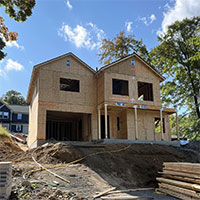What is a USDA construction loan?
These loans finance new builds in designated rural areas

For many homebuyers, it’s the realization of a dream: a house in the country, with acreage and distant neighbors. But the imbalance of home value to land value can make finding a mortgage challenging.
“When the land itself is worth more than the house that sits on it — or the home you plan to build on it — that’s considered a non-conforming loan,” said Reynolds Bickerstaff, a real estate broker at Bickerstaff Parham in Columbus, Georgia.
“The USDA construction loan is designed for situations exactly like this. It gives homeowners a way to finance both the acreage and the home they plan to build, combined into a single mortgage with one closing.”
USDA construction loans offer up to 100% financing on qualifying properties.
Jump to insightThe homebuyer and homebuilder must both meet USDA requirements to qualify.
Jump to insightFinding a financial institution to handle a USDA loan may be challenging.
Jump to insightWhat is a USDA construction loan?
A USDA construction loan is backed by the U.S. Department of Agriculture, as part of a program designed to make rural homes more affordable. USDA construction loans combine the purchase of land — usually five acres or more — with the cost of constructing a house on that land in a designated area.
As with a traditional USDA loan or other government-backed mortgages, homebuyers borrow from a traditional lender and the USDA backs the loan.
With the USDA construction loan, you have the convenience and reduced expense of a single-close loan that combines the land and the home’s construction cost.
These loans come with plenty of perks, such as a no down payment requirement. However, Bickerstaff warned that it can be challenging for homebuyers to find a lender with expertise in USDA loans. He suggests consulting a realtor or mortgage broker for recommendations.
» COMPARE: Best USDA lenders
How do USDA construction loans work?
As with any mortgage loan, you’ll be asked to submit an application that includes information about your past and current financial situation.
In addition, a USDA loan will require information about the property you plan to purchase to confirm it is in a USDA-designated rural area. Your builder will also have to meet USDA requirements in order for the loan to be approved.
Once you’ve secured a USDA construction loan, the loan itself works just like a traditional 30-year fixed-rate mortgage with regular monthly payments over the term of the loan.
Pros and cons of USDA construction loans
USDA construction loans can be a great option if you’re planning to build in a rural area, but they won’t suit everyone. Consider the pros and cons as you’re comparing borrowing options.
Pros
- No down payment requirement
- Finance land and home construction in one loan with one set of closing expenses
- Land-to-home value ratio shouldn’t be a concern
Cons
- Both borrower and property must meet USDA requirements
- Contractor/builder must meet USDA requirements
- Can be difficult to find a lender
How to get a USDA construction loan
The application process for a USDA construction loan isn’t much different from a traditional mortgage. Your application will be completed and submitted through a traditional bank.
However, because the loan is backed by the USDA, there are specific requirements for the homebuyer, the homebuilder and the property itself.
For the homebuyer
Your total household income cannot exceed the USDA income limits for your local area. These generally start at $110,650 for a household of up to four, but they may be higher based on an area's cost of living.
There is no prescribed minimum credit score requirement for USDA loans, but some lenders may set a minimum of 640.
In addition, you’re likely to need a debt-to-income ratio at or below 41%. The amount you spend on housing, including property taxes, insurance and homeowners association fees, can't be more than 29% of your income.
For the property
USDA construction loans are aimed at helping homebuyers in rural areas, so you may find that they include more property restrictions than conventional loans.
Your home will have to fall within one of the USDA's designated rural areas, and it must be your primary residence. Rental or vacation properties won’t qualify.
The USDA also stipulates that your new home must fit the area in order to qualify. This typically means the home cannot exceed 2,000 square feet, but certain exceptions may apply. You’ll want to discuss your plans with your lender as early as possible.
For the builder
A USDA new construction loan also has specific requirements for the contractors involved in the project.
Any builders must be approved by your lender, have at least two years of experience with single-family home construction and be fully licensed for the work. They must also have a strong credit history, clean background check and minimum of $500,000 in liability insurance.
Alternatives to USDA construction loans
If you have trouble finding a lender to handle a USDA construction loan — or if any part of your plan doesn’t meet USDA requirements — there are alternatives.
Many banks offer traditional construction-to-permanent mortgages that offer the same one-time close you’d have with a USDA loan.
In addition, there are other government-backed mortgages that offer no down payment, such as VA loans (for veterans, active-duty service members and surviving spouses of the U.S. military) and FHA loans (for homebuyers who may not meet the requirements for a conventional mortgage).
Both of these options have their own qualifying criteria, so talk to your banker or realtor about whether you qualify.
FAQ
Is it difficult to get a USDA construction loan?
The process itself is not difficult, provided you and your property meet the USDA requirements. You’ll need to allow time for your contractor or builder to be approved as well.
Do you need a USDA construction loan to build in a rural area?
You can finance home construction in a rural area without a USDA construction loan, but the USDA loan does offer distinct advantages for those who qualify.
What does a USDA construction loan cover?
Once you’ve qualified for a USDA construction loan, the proceeds from the loan can be used to purchase the land, cover the cost of home construction and a whole host of additional expenses, including:
- Inspection fees
- Builders insurance
- Construction administrative fees
- Permits
- Design plans
- Landscaping costs
- Building costs
- Utility and septic costs
Bottom line
While it may take some time to identify a lender and locate a qualified contractor, you will save cash if you qualify for a USDA construction loan. Plus, USDA financing can be used to cover nearly every foreseeable expense in building your home, so you can keep more cash on hand to cover additional expenses such as moving costs and utility connections.
“Your lender may not suggest a USDA construction loan as a first option for rural new construction,” said Bickerstaff. “USDA loans constitute less than 10% of transactions in a given area, but it’s definitely worth the extra effort to have your banker or realtor see if your property and home plans will qualify.”
Article sources
ConsumerAffairs writers primarily rely on government data, industry experts and original research from other reputable publications to inform their work. Specific sources for this article include:
- U.S. Department of Agriculture, “Single Family Housing Guaranteed Loan Program.” Accessed March 28, 2024.
- USDAProperties.com, “USDA Loan Income Limits and Eligibility in 2024.” Accessed March 28, 2024.
- Neighbors Bank, “USDA Loan Credit Score Requirements.” Accessed March 28, 2024.
- U.S. Department of Agriculture, “Chapter 11: Ratio Analysis.” Accessed March 28, 2024.
- U.S. Department of Agriculture, “Chapter 5: Property Requirements.” Accessed March 28, 2024.
- U.S. Department of Agriculture, “Combination Construction to Permanent Loans.” Accessed March 28, 2024.
